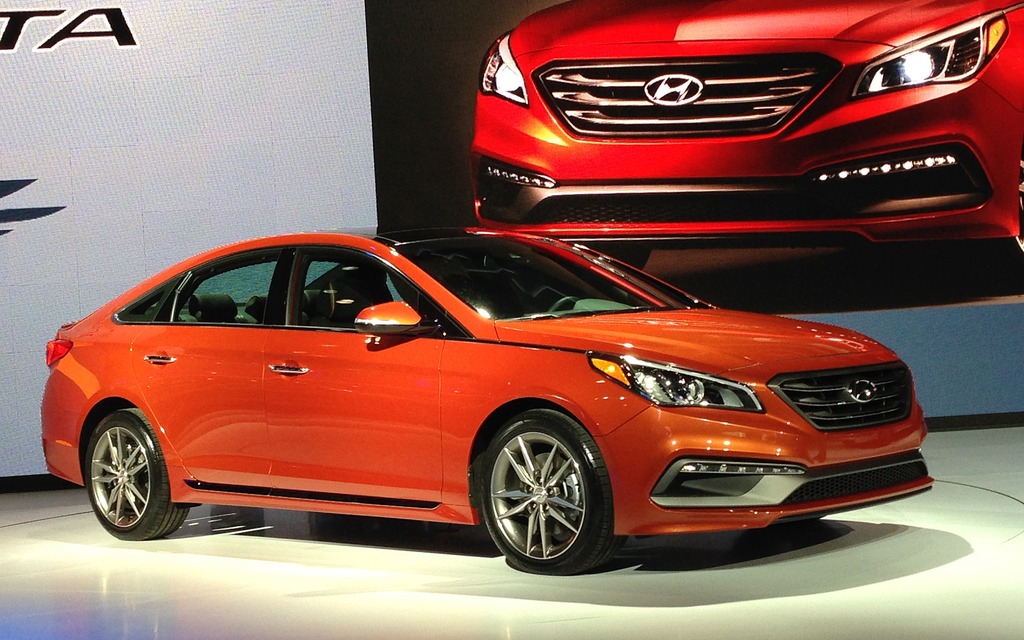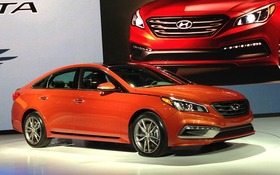2015 Hyundai Sonata : Things are getting serious
There were no standing ovations, there was no collective hysteria when Hyundai unveiled its fully revamped intermediate sedan at the New York Auto Show last week. Polite applause welcomed the 2015 Sonata, which first appeared in Canada in 1989 and is now in its seventh generation.
The bold card was played with the last generation. Launched in 2011, it featured a spectacular body with sweeping coupe-like lines that rivalled the likes of the Mercedes-Benz CLS and Volkswagen CC. It was designed at Hyundai’s California studio, which dubbed the style “fluidic sculpture.”
This time around, the Korean automaker is claiming to have created “fluidic sculpture 2.0” with the new Sonata. Its silhouette features the same themes present on the new Genesis sedan, which premiered at the Detroit Motor Show in January. This is especially true for the hexagon-shaped grille and less exuberant—and almost angular—lines of a classic sedan.
When looks are deceiving
And yet, the new Sonata is more aerodynamic than its predecessor, with a fantastic drag coefficient of 0.26 on the regular trim and 0.27 on the Sport 2.0T. This is thanks to the fact that the bumpers and rocker panels are more accentuated than before, the trunk is crowned with a rear spoiler and the vehicle is shod with wider tires. The previous Sonata’s drag coefficient was 0.28.
The new Sonata’s aerodynamic efficiency is also attributable to less visible components, such as the large polypropylene foam and carbon fibre panel that runs the length of the car and kills two birds with one stone by also improving soundproofing.
The Sonata has also taken on some size. It’s 35 mm longer, 30 mm wider, and 5 mm taller. The wheelbase has gained a whopping 105 mm in length, of which one quarter (25 mm) is for extra legroom in the back. The overhangs are therefore shorter, which enhances stability and agility.
Can’t wait to drive it!
Even though it’s broader, more spacious and comes with more equipment and safety systems than in the past, the Sonata has only gained a few extra kilograms. What is more, its body is now 41% and 35% more rigid in torsion and flexion, respectively, thanks to the fact that the body includes 51% high-strength steel that is 10% lighter.
The Sonata’s engineers optimized the geometry and calibration of the suspension, which includes a pair of lower control arms in back, compared to just one in the old model. The settings are firmer on the Sport trim, while the anti-roll bars are one millimetre thicker in front and in back.
The power-assisted rack and pinion steering is faster on all models and the new steering wheel boasts an “irregular” shape for a more natural grip. The Sport model gets a leather-covered steering wheel with shift paddles behind it as well as aluminum pedals. All Sonatas come with three driving modes: Eco, Normal and Sport. These adjust the settings and responsiveness of the accelerator, automatic gearbox and steering.
The Korean touch
The passenger compartment and dashboard are all-new, too. While Hyundai has already earned top marks for presentation on its most recent creations, the brand claims to have taken it a step further with the new Sonata. They have even gone as far as to carefully enhance the texture and feel of “all surfaces, buttons and controls that occupants come into contact with.”
We’ll judge for ourselves when we finally get to test the 2015 Sonata, but it certainly sounds promising. Especially since they resisted assigning a number of controls to one large dial, as many German automakers—and the 2015 Hyundai Genesis—have done. Instead, the centre console has two classic horizontal bars, each with a series of buttons and keys, and flanked by two small dials for the audio volume and temperature settings.
Directly above, there’s a standard five-inch touch screen, or an eight-inch one if you go for the optional navigation system. As is always the case at Hyundai, there are numerous practical storage compartments inside the cabin. They have also made it easy to integrate your electronic devices, with a pair of 12-volt outlets and standard ports inside the cubby under the console.
Buyers have the choice of six different equipment levels for the regular and Sport trims. The standard equipment, which is always outstanding at Hyundai, includes LED daytime running lights, power door locks and windows, heated front seats, a sound system with six speakers, a rear back-up camera and Bluetooth connectivity. If you want more, you can add a heated steering wheel, power-adjustable and cooled front seats, heated rear seats, xenon headlamps, parking sensors, a start button, and a more powerful sound system with nine speakers.
Down where it really counts
At first glance, nothing seems to have changed under the hood. Hyundai was the first to (wisely) do away with the V6 in its intermediate sedan. The new Sonata comes with the same pair of four-cylinder engines with dual overhead cams, direct injection and variable valve timing.
However, the naturally aspirated 2.4-litre and turbocharged 2.0-litre engines on the Sport models have both been meticulously updated. In both cases, total output has been reduced (from 190 to 185 horsepower for the first and 274 to 245 horsepower for the turbo). That said, maximum torque is now delivered at lower engine speeds, which should contribute to more flexibility, better pick-up and improved fuel economy.
This is probably a good time to mention that the current version of the Sonata Hybrid will not be updated at all—at least not for now. But it’s safe to bet that it will inherit the new architecture in the near future, as all of its major competitors offer a model of this kind. The Korean manufacturer is almost certainly preparing new hybrid models (including a rechargeable one) that will demonstrate clear progress in terms of fuel consumption and efficiency.
These are the rules of the game in this highly competitive segment, one that is of vital importance to big-name automakers in North America. The message is clear: in choosing substance over style, Hyundai is chasing after big sales numbers—not trophies—with its new Sonata. Maybe the Koreans have caught on to the fact that the Toyota Camry has been the best-selling car in the United States, its biggest market, for twelve years. And yet, the press barely noticed when it was updated in 2011.
Ironically, at the same edition of the New York Auto Show, Toyota unveiled a new “radically refreshed” Camry, featuring a much more eye-catching silhouette and grille. Kind of like the old Sonata. We’ll soon find who’s right.












